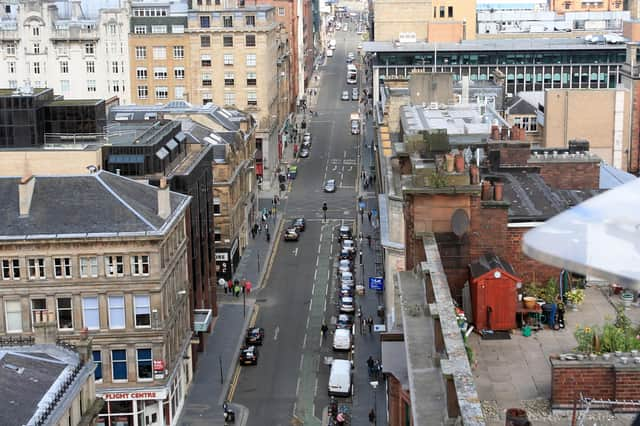After Covid, what will our cities of the future look like ? - Prof Brian Evans


As the pandemic struck, we reconfigured lots of city spaces to make them safer for people to physically distance and in doing so developed a new Scottish urban aesthetic – the boardwalk – which emerged though emergency and temporary roads regulations.
In April 2020, after suggesting such a thing, I was told “that’ll never happen here” … and then it did, after Paris and Milan showed the way.
Advertisement
Hide AdAdvertisement
Hide AdThis was followed in short order by the view that “it’s just temporary, and will have to go” inflamed perhaps by a justifiable suspicion that this has been a space grab by dangerous fifth columnists – cyclists, pedestrians and even environmentalists - all intent on punishing the motorist to a chorus of the city centres will die. We’ll see.
Let’s take a step back to the pre-occupations of urbanists and designers. John Higgs in his book Adventures in the 21st Century: The Future starts Here says that “if we are to build the city of the future, we must first imagine it” before he goes on to reflect on the consequences for our collective consciousness and mental health if the only futures we can imagine are apocalyptic and dystopian.
In recent work for the Long Now Foundation of San Francisco, Peter Leyden looks at our times from a perspective 80 years out. He doesn’t try to imagine life in 2100, but instead creates the space to imagine back to 2020-2050.
So as designers, as we imagine our way out of the pandemic, we can shift the needle away from apocalyptic dystopia to a more humane outcome through the intelligent harnessing of the current inexorable forces of change. Utopian visions can become achievable, ecophilic ambitions.
The task ahead is daunting. Switching the energy source of cars and public transport from fossil fuels to electricity or hydrogen and introducing a circular economy is only the start. We need to retrofit and decarbonise ALL off our existing buildings to do away with gas and we need to deal with water. Not just the water coming down our rivers from increased rainfall and extreme weather events, but the water coming up our firths and sea-lochs from increased sea-levels which if Goodell and others are to be believed is now inevitable.
Most of the population of Scotland and UK lives on or near the coast or tidal waterways. All this and we have not opened the box of populations displaced by climate change. How then are we to afford this, how are we to imagine it, and how are we to exhort people to follow their freewill and positively contribute? More emergency powers and regulations, without grants and financial incentives, seems a big ask.
We will see what emerges from the G7 meeting this weekend and from COP26 in November. Scotland is gearing up. Earlier this month the David Hume Institute published “A Scotland of Better Places” with some big place-based propositions: Reconnecting the Scottish Government and Communities, Infrastructure in Place, Elastic Space, Reversing Fiscal Centralisation, Making Land Work more effectively; Building Homes, Developing Community Capacities and Skills; and ‘Thinking Enterprise’.
Encouragingly, Deputy First Minister John Swinney made a commitment that the Scottish Government intends to move away from a programme of ‘portfolios and policy’ to one of ‘people and place’.
Advertisement
Hide AdAdvertisement
Hide AdDelivery will be ‘wrapped around the people of Scotland’ rather than expecting them to adapt themselves to the delivery systems of government agencies and local authority service provision.
It is encouraging and dead right to deconstruct action to deal with demographic, climate and technological challenges to the level of dealing with quality of life and quality of place at what the policy wonks refer to as the granular level – i.e. the community level.
As John Swinney has suggested, we need to find a way to wrap all this around people and work with them in their places and their lives. This will take some skill and insight.
Tackling big picture targets by working with communities to enhance their inherent creative capacity improves people’s places, people’s lives and gives them hope that the future can be a lot better than dystopia.
This means designing the programmes that can be applied at the local level. That takes skill, belief and commitment from politicians and professionals alike.
This year’s Scotland+Venice programme “What if …?/Scotland” launched last week at V&A Dundee and is intended to address the Biennale theme “How will we live’” through five pilots projects across Scotland that seek to re-engage the civic role of design professionals by asking citizens to share their hopes and dreams for the future of the places they call home. Could this be the big picture action played out at the community level of people and place that we need?
It’ll take courage and a hefty budget, but if it is properly resourced and if we engage the imagineers pouring out of our design schools and we trust them to get on with it, maybe, just maybe it is.
Brian Evans is Professor of Urbanism at the Mackintosh School of Architecture, the Glasgow School of Art and Glasgow’s City Urbanist
A message from the Editor:Thank you for reading this article. We're more reliant on your support than ever as the shift in consumer habits brought about by Coronavirus impacts our advertisers.
If you haven't already, please consider supporting our trusted, fact-checked journalism by taking out a digital subscription.
Comments
Want to join the conversation? Please or to comment on this article.